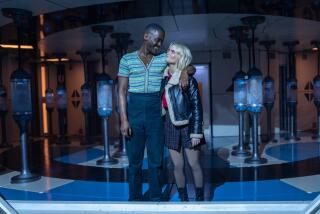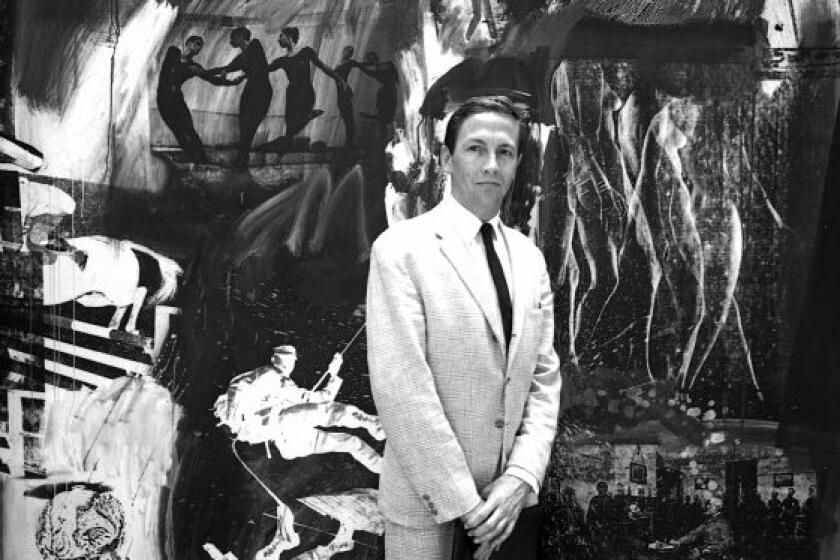AT 2 S.D. GALLERIES : CORITA KENT’S ART RETAINS FRESHNESS
During the 1960s, it was commonplace to see posters by Sister Mary Corita in the homes--especially the dining rooms--of socially aware, usually liberal, perhaps activist, families. She created many of her works in support of such groups as Amnesty International and Common Cause. Their bright colors conveyed joy and hope, their humanistic texts, love. It is a tribute to their quality as works of art that they still look fresh.
Two concurrent exhibitions give San Diegans an opportunity to see an unusually broad survey of the works of Corita Kent. The Acevedo Gallery (4010 Goldfinch) is exhibiting 100, the Art Gallery of the University of San Diego 30, out of a total of 800 she made during her lifetime. (She died in September.)
These are not great works of art, and the artist’s name does not appear in encyclopedias and textbooks of modern art. Nevertheless, they are very beautiful and meaningful to many people. It is more than pleasant and instructive to spend time with them. It is also moving.
The artist was born in Fort Dodge, Iowa, in 1918 but grew up in Hollywood. In 1936 she joined the order of the Immaculate Heart of Mary in Los Angeles, where she taught for 32 years. She headed the art department at Immaculate Heart College from 1946 until she returned to secular life in 1968, when she moved to Boston as a free-lance artist.
Her biggest works of art were the 40-foot Beatitudes mural for the Vatican pavilion at the New York World’s Fair in 1964 and a 150-foot rainbow commissioned by the Boston Gas Co. as adornment for a 17,400-square-foot storage tank. The smallest was a “Love” postage stamp, also with a rainbow, that appeared in 1985. (700 million of them sold!)
Kent is most widely known, however, for her colorful serigraphs, or silk-screen prints, in large editions, usually 200. She tried to live by the rule, “From each according to her abilities, to each according to her needs,” and to reach as many people as possible through her works by keeping the prices low.
Among the works at the Acevedo Gallery is her last serigraph, titled “Yes We Can,” with sinuous ribbons of pastel colors, commissioned through the gallery by and for the benefit of Los Ninos Education Center, a school for autistic children in San Diego.
Through both exhibitions it is possible to study Kent’s development from her early Byzantine-influenced works in rich, relatively static blendings of colors and letters, through the expressiveness appropriate to the turbulence of the 1960s, to the lyricism of the 1970s and 1980s.
She combined either abstract or semi-abstract forms with texts that she created or, more often, that she quoted from great writers such as Albert Schweitzer, Albert Camus and Martin Buber.
Two of her own are “Love is hard work,” with a rainbow, and “Each child is special. Give lots of love,” on a field of spots in primary and secondary colors. A favorite seems to have been “Flowers grow out of dark moments,” which appears in several contexts. Who can deny the truth of these statements? But Kent could be maudlin, too, as in “Would it embarrass you very much if I were to tell you that I love you?” with images of two red blossoms.
The exhibition at the Acevedo Gallery also includes a number of her landscape watercolors.
Colorful banners made by third-grade students from nearby St. Vincent’s School in emulation and honor of Kent add to the festiveness of the exhibition.
The works at the USD Art Gallery represent approximately one-third of a collection recently donated to the university by Robert Logan, a friend of Kent. The donation includes as well correspondence with her that will be preserved as an archive for student research.
“We are, of course, delighted with this gift,” professor of art Terry Whitcomb said. “It is a gift of love.
“Our university is an appropriate place for it. The works of Sister Corita were the first memorable visual experience for most of our students in the new Catholic liturgy. And now they can see her works in depth. They will be regularly exhibited in the new student center and circulate throughout the campus.
“Corita showed beauty to people in common images, and through common images, directed them to beauty.”
Or as Ralph Waldo Emerson wrote--in Kent’s version with a suggestion of yellow flowers, green leaves and blue sky--”The invariable mark of wisdom is to see the miraculous in the common.”
It is easy, too easy, to put down Kent’s prints as irrelevant to the “progress” of serious art. But as works of faith and love they are irresistible in their appeal to the heart.
The exhibition at the Acevedo Gallery continues through Jan. 31, at the USD Art Gallery, through May 31.
More to Read
The biggest entertainment stories
Get our big stories about Hollywood, film, television, music, arts, culture and more right in your inbox as soon as they publish.
You may occasionally receive promotional content from the Los Angeles Times.






